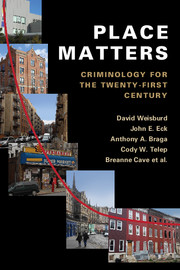Book contents
- Frontmatter
- Contents
- List of figures
- List of tables
- List of contributors
- Preface
- 1 Crime Places within Criminological Thought
- 2 The Concentration of Crime at Place
- 3 Theories of Crime and Place
- 4 The Importance of Place in Mainstream Criminology and Related Fields: Influences and Lessons to be Learned
- 5 Methods of Place-Based Research
- 6 Reducing Crime at High-Crime Places: Practice and Evidence
- 7 Crime Places in the Criminological Imagination
- Notes
- References
- Index
4 - The Importance of Place in Mainstream Criminology and Related Fields: Influences and Lessons to be Learned
Published online by Cambridge University Press: 05 April 2016
- Frontmatter
- Contents
- List of figures
- List of tables
- List of contributors
- Preface
- 1 Crime Places within Criminological Thought
- 2 The Concentration of Crime at Place
- 3 Theories of Crime and Place
- 4 The Importance of Place in Mainstream Criminology and Related Fields: Influences and Lessons to be Learned
- 5 Methods of Place-Based Research
- 6 Reducing Crime at High-Crime Places: Practice and Evidence
- 7 Crime Places in the Criminological Imagination
- Notes
- References
- Index
Summary
This chapter explores the importance of place in theory and research in both mainstream criminology and other disciplines. As we noted in earlier chapters, traditional criminology has focused primarily on understanding why people commit crime. This focus on criminality has generally inhibited study of microgeographies and their role in producing crime. However, more recently there has been a trend toward integrating microgeographic places into traditional theorizing about criminality. In the first part of the chapter we discuss this trend, focusing on some recent innovations in understanding criminality that have incorporated place-based perspectives. In the second part of the chapter we focus on how other disciplines have influenced thinking in this area, focusing in particular on contributions in psychology, economics, and public health. Finally, we explore how trends in other disciplines might influence future directions of study in the criminology of place.
THE GROWING ROLE OF MICROGEOGRAPHIC PLACES IN TRADITIONAL THEORIZING OF CRIMINALITY
As we noted in Chapter 1, places, at least at a macro level, played a key part in the development of criminology in the nineteenth and early twentieth centuries. But despite the role of place in crime in empirical study in Europe and theoretical development in the Chicago School through social disorganization theory, microgeographic places were mostly ignored. This was not because early criminologists failed to recognize the role of place in crime. Crime occurs in specific environments, and this was apparent to observers of the crime problem. Nonetheless, as we noted in Chapter 1, early criminologists did not see “crime places” – small discrete areas within communities – as a relevant focus of criminological study. This was the case, in part, because crime opportunities provided by places were assumed to be so numerous as to make concentration on specific places of little utility for theory or policy. What is the point of focusing theory or research on the opportunities offered by specific places if such opportunities can be found throughout the urban context?
Moreover, criminologists did not see the utility in focusing in on situational opportunities when criminal motivation was the key to understanding crime rates. Criminologists traditionally assumed that situational factors played a relatively minor role in explaining crime as compared with the “driving force of criminal dispositions” (Clarke and Felson 1993, 4; Trasler 1993).
- Type
- Chapter
- Information
- Place MattersCriminology for the Twenty-First Century, pp. 68 - 85Publisher: Cambridge University PressPrint publication year: 2016



